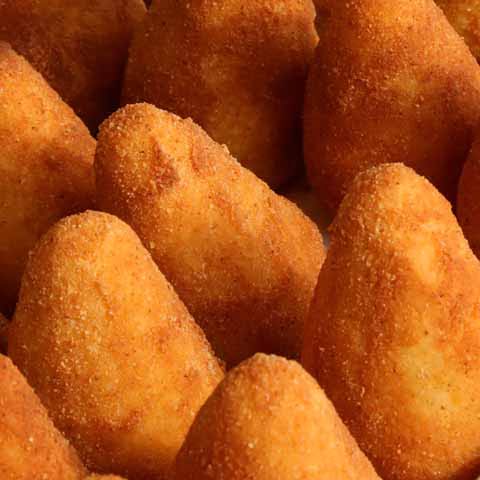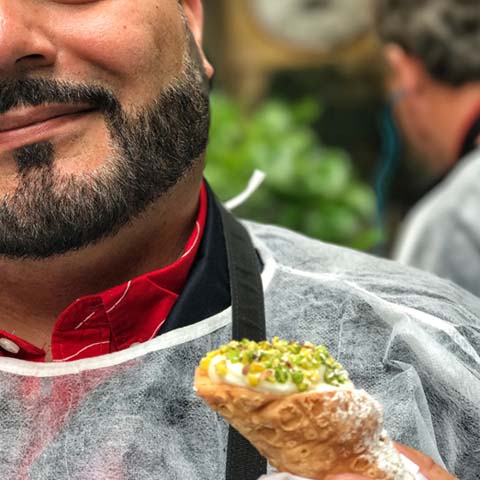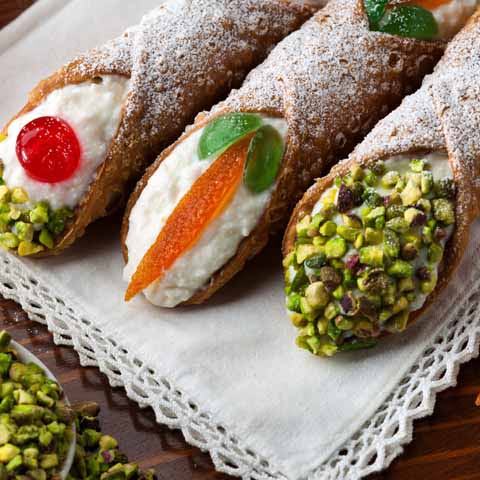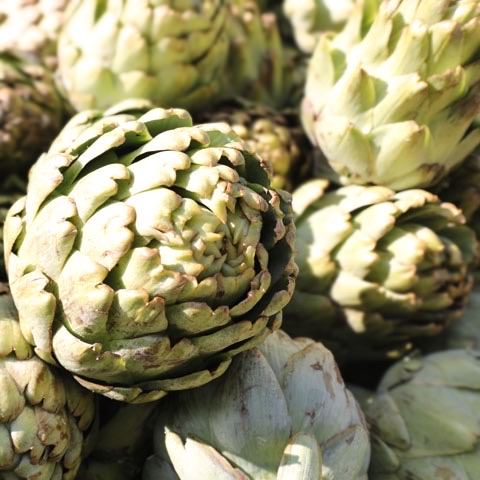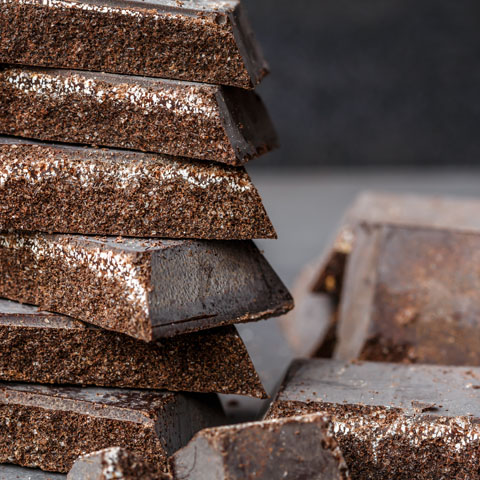Sicily is a region known for its remarkable cuisine which is characterized as being multicultural, rustic, and simple, yet delicious. Like the cultural influences that inspire Sicilian food, the cuisine of the cities throughout Sicily can vary. Ragusa is no different. The city offers unique and interesting dishes that are comprised of fresh, local ingredients from surrounding ranches and farms.
Ragusa is known for its high-quality food and wine. It is home to countless local products acknowledged by the EU, and its cuisine has been celebrated by writers and poets for centuries. William Shakespeare wrote about Hyblaean honey – a variety of honey only prepared in this small area of Sicily – and the Roman historian Cato documented Ragusa’s cassateddi – a delicious ricotta and cinnamon dessert.
Hyblaean honey is noteworthy due to its quality, which has made it one of the most celebrated types of honey in the world since ancient times. Honey production in Ragusa can be divided into two categories: nectar honey, which derives from the nectar of the flower, and honeydew honey, which is made from aphid secretion (called honeydew). The former type can be further divided into multi-floral honey or uni-floral honey, and both of these are produced in Ragusa, though uni-floral is more prevalent. The honeydew honey (also known as forest honey) produced in Ragusa is typically made using citrus trees, which impart a sweet and delicate taste. Generally speaking, nectar honey is more commonly produced in Ragusa with a variety of flavors and colors based on the plant used. The most popular plant types for honey in Ragusa include thyme, orange blossom, carob, eucalyptus, honeysuckle, and chestnut.
To experience Ragusa’s cuisine firsthand, travelers can enjoy dining at any of the city’s restaurants, bars, or cafes. Prepare for cuisine that is delicious and simple, unfettered by an abundance of ingredients, garnishes, or complicated recipes. Expect dishes that feature meats, legumes, olive oil, vegetables, and a variety of cheeses.
Ragusa is also known for its bread, of which there are several varieties. The traditional bread that is characteristic of the area is called pane di pasta dura or hard dough bread. Served at nearly every meal, pane di pasta dura differs from bread made in other parts of Sicily due to the use of durum wheat flour and a small amount of water when forming the dough. The dough is heavily kneaded, leading to a very dense consistency.
Preserves, a typical product throughout the Hyblaean area for centuries, are worth a mention as well. As a fundamental part of the local cuisine, preserves can be made at home or on an industrial level. The most characteristic varieties in this area include various types of local tomatoes (including sundried), olives, garlic, peppers, onions, eggplants, asparagus, and capers.
Last, but not least, native plants make indispensable contributions to the local cuisine. Foremost among these is the carob tree, which is native to the area and found throughout the Hyblaean zone. The carob fruit is ground into a flour and used to make local products and sweets, such as carob cookies. Additionally, a rare and highly renowned type of mushroom (called fungo di carrubo) can grow on the trunk of the carob tree.
The countryside surrounding Ragusa is also dotted with a variety of wild plants that may be incorporated into local dishes or served as a side dish. These include the prickly pear, which is prevalent throughout Sicily, as well as fennel, mustard, asparagus, arugula, radish, sowthistle, and purslane. Though many of these plants are typically cultivated in other parts of Italy, the wild varieties found throughout the Hyblaean zone impart unique flavors and are emblematic of Ragusa’s simple, peasant cooking.
With the basic typical products and components of Ragusa’s cuisine covered, let’s now dive into a few typical dishes.
APPETIZER
A common starter in Ragusa is scaccia. Prevalent in other parts of Sicily as well under different names, scaccia is a flatbread made with very thin dough that is layered with different fillings. In Ragusa, typical scaccia fillings include ricotta cheese, which can be paired with onions, meat, or vegetables, as well as tomato sauce, which can be paired with salted anchovies and parsley. Scaccia in the Ragusa area is shaped like a rectangle with the short end of the dough closed by hand prior to baking.
In addition to scaccia, another bread-based appetizer popular in Ragusa would be ‘Nfigghiulate. These delicacies are made by stuffing dough with ingredients like sausage, lemon balm, and cacaiocavallo ragusano, then rolling the dough, and cutting it into thick slices before baking it. The result is a savory treat with a distinct pinwheel shape.
In Ragusa, as is the case throughout Italy, appetizers usually feature an assortment of local cured meats, cheeses, and vegetables. Due to the prevalence of ranching in the countryside surrounding Ragusa, the area is highly-renowned for its cheeses.
The signature cheese of the area is called caciocavallo ragusano. It is a DOP cheese produced from milk originating in the Ragusa countryside. It is offered in multiple varieties based on the cheese’s age – fresh and mild, semi-aged, and fully aged sharp. It can be served in a variety of ways, such as grated on pasta or paired with a piece of meat, but by far the best way to appreciate the unique flavor of this cheese is to enjoy it as an appetizer together with homemade bread drizzled with extra virgin olive oil (such as Monti Iblei DOP) or locally made conserves (featuring ingredients such as olives or tomatoes).
Another common pairing for cacaiocavallo ragusano is capuliato, which is a local condiment made from ground sundried tomatoes that are marinated in olive oil with basil and oregano. Depending on personal preference, other flavors can be added to the base recipe such as garlic, red chili pepper, or bay leaves. In Ragusa, capuliato may accompany cheeses as an appetizer or it can be served as a pasta sauce, used to season vegetables, incorporated in bruschetta, or included in scaccia filling.
Other top Sicilian cheeses to try include provola ragusana, ricotta iblea, and tuma. Additionally, in the mid to late 1990s and early 2000s, ranchers in the Hyblaean area began to raise buffaloes leading to the production of cured meats made from buffalo, buffalo milk, and cheeses made from buffalo milk including mozzarella and ricotta. Though relatively new compared to other areas, buffalo products from Ragusa and the surrounding area are already considered delicacies.
FIRST COURSE
A commonly served first course in Ragusa is macco, a soup made of fava beans and wild fennel.
As for pasta dishes, the king of the first course in Italy, cavati (or cavatelli) is a popular pasta shape throughout the area. A common practice in Ragusa is to serve cavati together with ravioli (stuffed with locally made ricotta, of course). Known as cavati e ravioli alla ragusana, the pasta is typically served with a pork sauce made by slow cooking pieces of pork and sausage in tomato puree.
It should also be mentioned that a variety of tomatoes are grown in the area surrounding Ragusa such as datterino, grappolo rosso, ciliegino, and cuore di bue. These tomatoes can be prepared in different ways, such as sundried, or they can serve as the base for pasta sauces. In this area, elioconcentrato is prevalent as well, which is a concentrated tomato sauce made by spreading tomato puree on wooden tables or ceramic trays, covering it with a thin layer of cloth, and leaving it to dry under the sun.
In the Ragusa area, homemade pasta is prevalent with a variety of simple shapes popular among the locals, including cavatuna and tagliatelle. This category of pasta, always made by hand, is referred to as a pasta ri casa.
Other pasta dishes include lolli ‘cche favi (handmade pasta with fava beans or pureed fava beans), pasta o’furno (baked pasta with ingredients that can vary from family to family), pasta co capuliato (pasta with capuliato that can be topped with breadcrumbs and grated local cheese), and pasta che paddunedda (homemade pasta with broth and small meatballs).
Finally, though seafood is not a large component of the local cuisine compared to meat, it can appear in pasta dishes such as ravioli di ricotta al nero di seppia (ricotta ravioli with cuttlefish ink).
SECOND COURSE
Unlike other areas of Sicily, Ragusa’s meals do not typically include much fish or seafood. While there are the occasional fish dishes with influences from the nearby coast, much of Ragusa’s second courses are based on meat.
Common meats used in the second course throughout Ragusa include pork, chicken, lamb and rabbit. Pork is served frequently in the form of stuffed chops or in sausages. Stuffed meats are common in Ragusa in general, so it is not uncommon to find items like stuffed hen or rabbit as well.
Pastieri are another common and unique dish. These pastries are filled with minced meat such as lamb or veal and contain spices, caciocavallo ragusano, potatoes, vegetables, and more. Pork and rabbit varieties are available as well. A similar dish would be tomasini, which are composed of dough usually stuffed with ricotta and sausage.
Though not as prevalent, a few popular seafood dishes in the area include octopus served with potatoes as well as stuffed squid, steamed sea bream, and steamed mussels. Seafood is often fried in the area too, and common varieties include fried small red mullets, squid, cuttlefish, and rays.
SIDE DISHES
Vegetables are the stars of the local side dishes in Ragusa and are served with plenty of herbs. They can be prepared many different ways including sauteed, stuffed, steamed, baked, fried, or eaten raw. Some typical vegetables include artichokes, mushrooms, olives, eggplants, cauliflower, beans, and onions.
Common side dishes include fried wild asparagus, artichokes stuffed with breadcrumbs and/or sausage, pipi arrustuti (grilled peppers), fried olives, and milinciani ‘a parmigiana (fried eggplants baked with tomato sauce and parmigiano).
STREET FOOD
Like other areas throughout Sicily, arancini are the must-have street food in Ragusa. Deep fried, stuffed rice balls, arancini are delicious, crunchy, cheesy delights that are great for enjoying while strolling the streets. Ragusa’s arancini, in addition to being stuffed with the usual ragù and peas, also feature hard-boiled eggs and caciocavallo ragusano.
DESSERTS
As for those with a sweet tooth, desserts in Ragusa include a variety of cookies, cakes, and cold items. Typical dessert ingredients in the area include almonds, honey, and sweetened ricotta.
A common pudding served throughout the area is called biancomangiare. It is a classic pudding from the Middle Ages that is made with milk and almonds.
As for baked goods, local pastry shops serve up mucatoli (cookies made with dried fruit) as well as almond biscuits, cannoli filled with ricotta iblea, and cakes made with fruit flavors such as orange. One of the most common cakes of the region is cassata – a ricotta sponge cake that is moistened with fruit juice or liqueur and topped with candied fruit. Special mention goes to cassatelle, a baked pastry filled with sheep milk ricotta or ricotta iblea.
A trip to Sicily is not complete without a granita. A granita is a semi-frozen dessert that has a slushy and granulated texture. A typical Sicilian breakfast is not complete without a granita and brioche. Flavors that are popular throughout Sicily include lemon and almond, while in Ragusa specifically you can find granita made with locally grown mulberries as well as Modica chocolate.
Speaking of, another must try when in Ragusa is Modica chocolate – a Sicilian delicacy that is for true cocoa lovers and only produced in the nearby town of Modica. The chocolate has a rough and grainy texture that is derived from an Aztec recipe. The chocolate can be flavored with many different ingredients including cinnamon, vanilla, chili pepper, coffee, or citrus fruits.
Also hailing from Modica is a special type of stuffed cookie called ‘Mpanatigghi. In addition to typical sweet ingredients like almonds, chocolate, sugar, and cinnamon, these cookies are also filled with a hint of ground beef. This may sound strange, but these unique treats are definitely a must-try when in the area.
WINE IN RAGUSA
The region of Sicily has more vineyards than any other Italian region. Lovers of wine will appreciate not only the delicious varieties available throughout the region, but the history of winemaking held within the walls of local wineries.
Ragusa is known for its full-bodied red wines. The area of Southeast Sicily is ideal for growing Nero D’avola and Frappato grapes, which are used to create some of the region’s best wines.
Some key regional wines to try include Cerasuolo di Vittoria, Ambrato di Comiso, Eloro, and Albanello. Others include the spicy red Il Moro and the light and fresh Il Frappato.
The food and wine featured in Ragusa are steeped in centuries of history and offer the best flavor combinations of the local land of this ancient city.
Don't just see Italy, live it.
Your dream trip to Italy has never been closer
No more endlessly scrolling travel sites. Our travel experts will craft the perfect, one-of-a-kind trip just for you.

300+
DESTINATIONS
We offer more Italian destinations than any travel site. Do and see more with Trips 2 Italy.
1 (of a kind)
ITINERARIES
Because your dream trip to Italy should be designed for you, not for the masses.
100%
PEACE OF MIND
From flights and accommodations, to food and activities - we take care of every detail.
